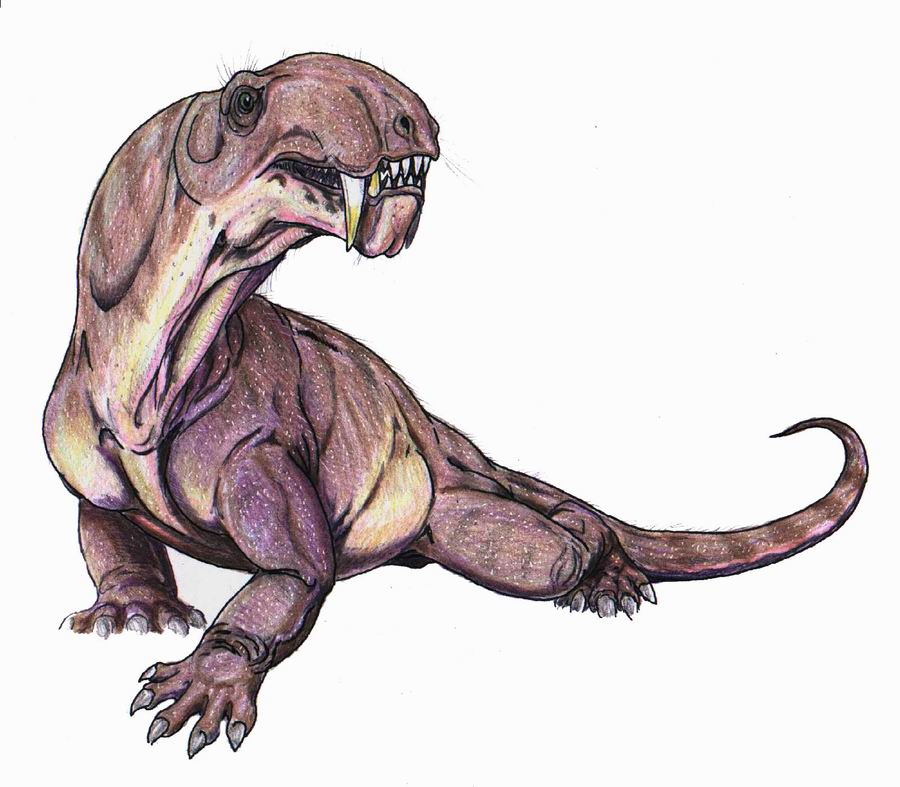- Biarmosuchia
Taxobox
name = Biarmosuchia
fossil_range = MiddlePermian - LatePermian

image_width = 215 px
image_caption = "Ivantosaurus ".
regnum =Animal ia
phylum = Chordata
subphylum = Vertebrata
superclassis =Tetrapod a
classis =Synapsid a
ordo =Therapsida
subordo = Biarmosuchia
subdivision_ranks = Families
subdivision =
*Biarmosuchidae
*Burnetiidae
*Eotitanosuchidae
*Hipposauridae
*Ictidorhinidae
*?Niaftasuchidae
*?Phthinosuchidae
*RubidginidaeThe Biarmosuchia, also known as the Eotitanosuchia and the Phthinosuchia are an assemblage of primitivePermian Therapsida that represent either aparaphyletic stem group or a very early off-shoot of the main Therapsid tree.They were moderately sized, lightly built carnivores, intermediate in form between the Sphenacodont
Pelycosaur s and more advancedtherapsids .Characteristics
The Biarmosuchian
skull is very similar to the sphenacodont skull, differing only in the largertemporal fenestra (although these are still small relative to later therapsids), slightly backward-slopingocciput (the reverse of the Pelycosaur condition), reduced number of teeth, and single largecanine teeth in both upper and lower jaws, and other features (Carroll 1988 pp.370, Benton 2000 p.114). In later specialised Biarmosuchia, these resemble the enlarged canines of theGorgonopsia . The presence of larger jaw-closing muscles (and hence a stronger bite), as indicated by the flaring of the rear of the skull where these muscles were attached.The
vertebrae are also sphenacodontid-like (but lack the long neural spines that distinguish "Dimetrodon " and its kin), but the shoulder andpelvic girdle s and the limbs indicate a much more advanced posture. The feet are more symmetrical, indicating that they faced forward throughout the stride, and thephalange s (toes) are reduced in length so that they are more like that of latersynapsids (therapsids andmammals ) (Carroll 1988 pp.370-1).Distribution
Biarmosuchia are known from both
Russia ("Phthinosuchus ", "Biarmosuchus ", "Eotitanosuchus ") and the South African (Ictidorhinidae ,Burnetiidae , and associated forms), and are totally restricted to the Middle and LatePermian Taxonomic history
Hopson and Barghusen (1986 p.88) tentatively united the Biarmosuchidae and Ictidorhinidae (including Hipposauridae and Rubidginidae) as the "Bairmosuchia", but were undecided as to whether they constituted a natural group or an assemblage that had in common only shared primitive characteristics. They thought "Phthinosuchus" too poorly known to tell if it also belonged, but considered "Eotitanosuchus" a more advanced form.
Sigogneau-Russell (1989) erected the infraorder Biarmosuchia to include the families Biarmosuchidae, Hipposauridae and Ictidorhinidae, distinct from the Eotitanosuchia and the Phthinosuchia.
Ivakhnenko (1999) argued that "Biarmosuchus tener", "Eotitanosuchus olsoni", and "Ivantosaurus ensifer", all known from the
Ezhovo locality, Ocher Faunal Assemblage, are actually the same species. Even if these taxa are shown to be distinct, Ivakhnenko's paper indicates that Eotitanosuchus are Biarmosuchus are very similar animals. Ivakhnenko also relocates the family Eotitanosuchidae to the order Titanosuchia, superorderDinocephalia .Benton 2000 and [http://palaeo.gly.bris.ac.uk/benton/vertclass.html 2004] gives the Bairmosuchia the rank of suborder.
ee also
*
Evolution of mammals
*Permian tetrapods
* "Tetraceratops "References
* Benton, M. J. (2000), "Vertebrate Paleontology", 2nd Ed. Blackwell Science Ltd (2004) 3rd edition
* Carroll, R. L. (1988), "Vertebrate Paleontology and Evolution", WH Freeman & Co.
* Hopson, J.A. and Barghusen, H.R. (1986), An analysis of therapsid relationships in N Hotton, III, PD MacLean, JJ Roth and EC Roth, "The Ecology and Biology of Mammal-like Reptiles",Smithsonian Institute Press , pp. 83-106
* Ivakhnenko, M.F. 1999, Biarmosuches from the Ocher Faunal Assemblage of Eastern Europe,Paleontological Journal vol 33 no.3 pp. 289-296. [http://www.maik.rssi.ru/cgi-bin/search.pl?type=abstract&name=paleng&number=3&year=99&page=289 abstract]
* Sigogneau-Russell, D., 1989, "Theriodontia I - Phthinosuchia, Biarmosuchia, Eotitanosuchia, Gorgonopsia" Part 17 B I, "Encyclopedia of Paleoherpetology",Gutsav Fischer Verlag , Stuttgart and New York,External links
* [http://www.palaeos.com/Vertebrates/Units/400Therapsida/200.html Therapsida: Biarmosuchia] at Palaeos
Wikimedia Foundation. 2010.
